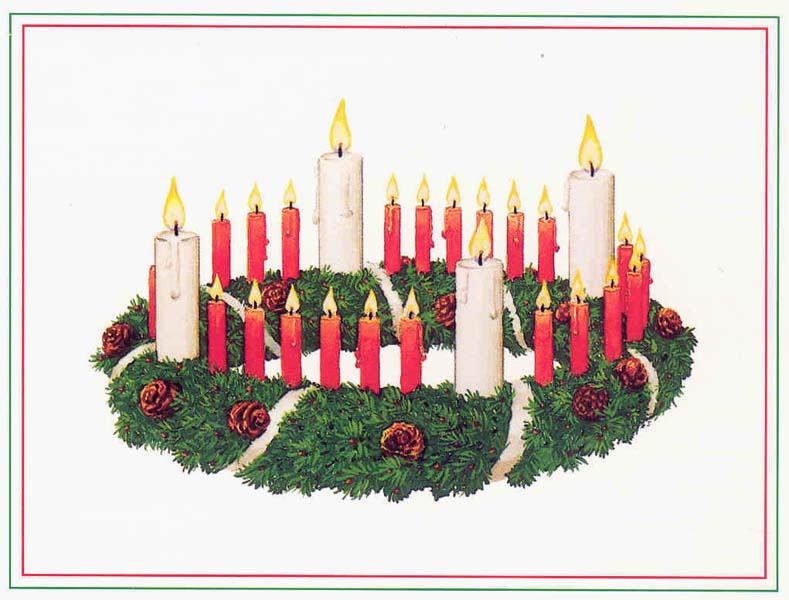Appointments for Christmas
|
Contents
|
This page covers matters related to worship appointments
for the Dodekaemeron of the Nativity of Our Lord
(the Twelve Days of Christmas).
If you have not reviewed the general information on planning liturgy, worship appointments, etc., please do so at our Worship Aids for Pulpit Vacancy page.
Paraments and Vestments
The color for the Dodekaemeron of the Nativity
of Our Lord is white.
Feasts that fall within the Dodekaemeron, e.g.,
the Feast of St. Stephen and the Feast of the Holy
Innocents, both of which being classified as lesser
festivals, are red.
 "Luther Amidst his Family at Wittenberg on Christmas Eve, 1536," steel engraving, Sartain’s Union Magazine of Literature and Art (Philadelphia: John Sartain & Co., c.1860). (Public domain) |
The Christmas Tree
Erection & Lighting
The Christmas tree was not originally associated with the
sanctuary; its place was the home but eventually migrated
into the sanctuary (though more recently than most people
realize). As the name indicates, the Christmas tree is
proper to Christmas, not Advent. If the Christmas tree is
erected during Advent, consider not lighting it until
Christmas Eve as a way of marking the distinction between
the two times and as a way of highlighting the high feast
of the Nativity of Our Lord. If a Christmas tree is
erected in the sanctuary, it is kept up and lit throughout
the Dodekaemeron (Twelve Days) of Christmas,
beginning with sundown on December 24 and continuing
through January 5. Obviously, the lights may be
extinguished between services—we prefer not to set the
church building on fire. We recommend that the Christmas
tree be lit before the people gather for worship and
extinguished after they leave.
Ornamentation
Ornamentation for the Christmas tree has varied
throughout the ages. Around the 1970s, there was a push
for the employment of Chrismons in place of other tree
ornaments. There is nothing wrong with Chrismons, but we
have noticed that many Chrismons, having been fabricated
five decades ago, are reaching the end of their useful
life. A congregation may certainly fabricate replacements,
but it is also fine to hang Christmas tree balls. Some of
the oldest known Christmas tree ornaments resembled (or
were unconsecrated) celebrant's hosts (the large communion
wafers used by the pastor at altar). Also among older
ornaments were fruits or balls (intended to resemble
fruits). The Christmas tree was not simply an evergreen
tree brought inside as a pretty plant. It was a symbol of
the Tree of Paradise, the "tree of life," reported in the
Book of Revelation:
Then the angel showed me the river of the water of life, bright as crystal, flowing from the throne of God and of the Lamb through the middle of the street of the city. On either side of the river is the tree of life with its twelve kinds of fruit, producing its fruit each month; and the leaves are for the healing of the nations (Rev. 22:1-2, NRSV).
The use of celebrant's host, fruits, and balls was meant
to evoke the twelve fruit of the tree of life. A
congregation may want to, in that spirit, place twelve
different ornaments on the tree, being careful to pick
items that will help bring to mind the tree of life
(rather than distract).
Removal of the Christmas tree
The Christmas tree should be removed prior to the
Epiphany service. One may burn the Christmas tree and any
other greens on the Feast of the Epiphany—this is not
recommended if the tree is made of plastic.
 The
Advent Wreath
The
Advent Wreath
As the name indicates, the Advent wreath is proper to
Advent, not Christmas. It should be removed prior to the
Christmas Eve service. The use of a white candle (as a
central fifth candle, sometimes called "The Christ
candle") with an Advent wreath is an exceptionally recent
innovation and should be avoided as it is explicitly
outside of Advent. For more on the Advent wreath, visit our
Appoints for Advent page.
Paschal Candle
The Paschal candle is not lit during Christmastide
except for baptisms and funerals. Furthermore, the Paschal
candle is never incorporated into the Advent wreath. Visit
our Paschal candle page
for details.
Other Candles
The lighting and extinguishing of candles for the Sunday morning service is a matter of local custom. Some congregations have rather elaborate rituals for doing so. Others struggle to find acolytes. If lighting and extinguishing the altar candles has become a challenge, a congregation might follow the advice found in the Manual on the Liturgy—Lutheran Book of Worship, lighting the candles well before the service and extinguishing them well after the service, doing so decorously but without pomp and circumstance. This, then, can be done by ushers, the sexton, the altar guild, the pastor, etc. without vesting.
Flowers
Flowers are lovely and a fitting adornment. Flowers,
however, should not placed on the mensa (tabletop
of the altar). Most non-freestanding altars feature a
gradine (a raised shelf at the rear of the altar). Flowers
may be placed on the gradine along with altar candles. A
freestanding altar (or communion table) poses a challenge
to flower placement. If there is an old high altar with
gradine in the apse or a reredos with shelves for flowers,
the problem is solved. Flower floor stands can be used, or
the flowers may be simply set on the floor in the front of
the altar as it is faced by the congregation, assuming the
pastor presides from the other side. Flowers should not
pose a fire hazard in their placement or a tripping
hazard.
If you haven't read about Advent...
If you haven't read about Advent, you might want to take
a look at our Appointments
for Advent page.
West Virginia-Western Maryland Synod,
℅ St. Paul Lutheran Church, 309 Baldwin Street, Morgantown, WV 26505
304-363-4030 + Porter@WV-WMD.org